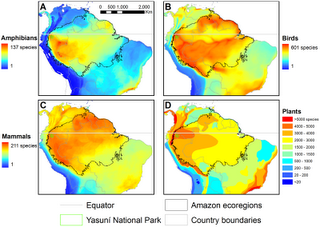-
The Yasuní-ITT Initiative Is a Practical Climate Solution That Must Be Embraced at Durban
November 28, 2011 By Ivonne Baki
As the world turns to Durban, South Africa, for this year’s UN climate summit, new findings are turning up the heat on the urgency to address climate change. The reality though is that we no longer have the luxury of resting our hopes solely on an internationally binding climate agreement; we must begin to look more closely at supporting immediate and tangible solutions. By complementing a global top-down effort of continued international negotiations with bottom-up approaches, we increase our chances at mitigating the most damaging effects of climate change. One of the most innovative models of such a bottom-up approach is the Yasuní-ITT Initiative being undertaken by the Government of Ecuador and supported by the UN Development Programme’s Multi-Partner Trust Fund Office (MPTF Office).
The Yasuní-ITT Initiative prevents a significant output of carbon dioxide while preserving biodiversity and indigenous rights by keeping the petroleum industry permanently out of the Ishpingo-Tambococha-Tiputini oil fields, located predominantly within Ecuador’s Yasuní National Park. In exchange, Ecuador is compensated, through a voluntary international fund, for a fraction of the oil’s value, which goes towards funding renewable energy projects and sustainable development – a true intersection of environmental security issues.
The initiative may serve as a model for developing counties seeking to shift away from carbon-laden industrialization towards renewable energy matrices and needs to be seriously debated at Durban. But this first-of-its-kind program needs more support from the international community in order to make the loss of oil revenues politically viable.
The Yasuní-ITT Initiative
The ITT oil fields, deep within the Ecuadorian Amazon, hold 846 million proven barrels of heavy crude oil, accounting for 20 percent of Ecuador’s proven reserves. But these fields are located beneath one of the most biodiverse spots in the Western hemisphere.
In April 2007, Ecuadorian President Rafael Correa stated that his administration’s preferred option for the ITT was to leave the oil permanently beneath Yasuní National Park in exchange for partial compensation from the international community of forgone revenue. Ecuador officially launched the Yasuní-ITT Initiative in June 2007. The primary goals of the initiative, codified in President Correa’s address at the UN General Assembly in 2007, are to respect the territory of indigenous peoples, particularly of those who choose to live in voluntary isolation; protect the park and its biodiversity; and mitigate climate change by keeping 407 million metric tons of CO2 out of the atmosphere.
Dr. Eric Chivian, founder and director of Harvard’s Center for Health and the Global Environment on Yasuní’s biodiversity. To support the innovative initiative, the Government of Ecuador, with the support of the UNDP, established the Yasuní-ITT Trust Fund in August 2010. Administered by the MPTF Office, the fund’s objectives are to raise half of the expected oil revenues (in 2010 prices) and channel contributions into two windows. The first window’s objectives are to help finance renewable energy projects (hydro, geothermal, solar, wind, biomass, and tidal plants) to offset the presumed loss of power production. The second’s objectives are to fund sustainable development programs (conservation, reforestation, energy efficiency, social programs, and research). In exchange for these contributions, the fund provides certificates of guarantee ensuring that “the crude [would] stay, in an indefinite manner, below ground.”
Crowd Funding for Yasuní: Time Is of the Essence
When the fund was established, the UNDP and the Government of Ecuador set a goal of raising $100 million in contributions by December 2011 to test the viability and international support of the initiative. At a high-level meeting on the Yasuní-ITT Initiative during the UN General Assembly this September, Secretary General Ban Ki-moon and President Rafael Correa announced $52.9 million in contributions from Italy, Australia, Turkey, Colombia, and Peru, amongst others, but the outstanding balance of sought-after contributions remains unmatched. Next month, there will be a complete review, at which point if the sought-after contributions are not received, it will become increasingly more difficult to maintain a policy of non-extraction in Quito.
Given the position of petroleum in its economy, Ecuador is willing to make a tremendous financial sacrifice by supporting this initiative. Petroleum accounts for nearly half of all of Ecuador’s exports and one-third of tax revenues. According to a study by Carlos Larrea of the Simon Bolivar Andean University, Ecuador would receive around $7.25 billion in revenues if the oil were extracted (that estimate, however, was based on the benchmark price of $76.38/barrel of WTI crude, which hovered around $96/barrel this week). The Ecuadorian government seeks half of the expected 2010 oil revenues and will foot the rest. GDP per capita was $4,290 in 2010. Over a third of the country’s population – 36 percent – live below the poverty line. Despite all of this, there is strong domestic support for the initiative. Of the 63.4 percent of Ecuadorians polled last month who knew of the Yasuní-ITT Initiative, 83.4 percent supported the initiative. Just this past weekend, Ecuadorian citizens donated over $2 million to the initiative during a civic campaign.
Carbon Mitigation, Biodiversity Protection, and the Rights of Indigenous Peoples
Global carbon dioxide output in 2010 grew by 564 million tons more than in 2009 – an increase of almost six percent. At these levels of output, the IPCC has forecasted temperature rise between 4°F and 11°F by the end of century, the median figure of 7.5°F being the best estimate. By not extracting the oil underneath the ITT block, the world would avoid the release of an additional 407 million metric tons of CO2. If last year’s increased output pushed global temperature rise into worst case scenarios for this century, imagine adding the CO2 output from Yasuní’s petroleum?
 There is more to the Yasuní-ITT Initiative than merely mitigating climate change though; it is also about protecting valuable species diversity. The Yasuní National Park benefited from being a refuge during the Pleistocene Era – it was one of three places in the Amazon that did not freeze over during the Ice Age. According to a 2010 study in the science journal PLoS One, a typical hectare (2.54 acres) of forest in Yasuní contains upwards of 655 tree species – more than is native to the continental United States and Canada combined – as well as 100,000 species of insects. One section of the park holds at least 200 species of mammals, 247 amphibian and reptile species, and 550 species of birds, making Yasuní National Park one of the most biodiverse places on Earth.
There is more to the Yasuní-ITT Initiative than merely mitigating climate change though; it is also about protecting valuable species diversity. The Yasuní National Park benefited from being a refuge during the Pleistocene Era – it was one of three places in the Amazon that did not freeze over during the Ice Age. According to a 2010 study in the science journal PLoS One, a typical hectare (2.54 acres) of forest in Yasuní contains upwards of 655 tree species – more than is native to the continental United States and Canada combined – as well as 100,000 species of insects. One section of the park holds at least 200 species of mammals, 247 amphibian and reptile species, and 550 species of birds, making Yasuní National Park one of the most biodiverse places on Earth.This incredible biodiversity also holds the potential for scientific and medical breakthroughs. “Yasuní’s enormous biodiversity will lead to new medicines and medical-research models to treat human diseases and relieve human suffering,” says Founder and Director of Harvard’s Center for Health and the Global Environment and Nobel Peace Prize co-winner Dr. Eric Chivian. “If the Yasuní is destroyed we may lose those species of amphibians that contain painkillers that are better than any we have and that contain antibiotics that will prevent the crisis of antibiotic resistance that is coming down the pike,” he warns (see video above).
On top of these issues is Ecuador’s commitment to its indigenous population. Ecuador has realized that indigenous rights cannot be secured without simultaneously ensuring environmental protection. Two relatives of the Waorani Indigenous group (the predominant indigenous group of the Yasuní National Park), the Tagaeri and the Taromenane, live in voluntary isolation deep within the park’s boundaries, precariously close to the ITT zone. They depend on Yasuní for their survival, and their way of life would be forever altered by oil extraction in the ITT block.
The Way Forward
Many developing countries have their eyes on the Yasuní-ITT Initiative. If the initiative fails to garner international support, it will discourage developing countries from adopting bold climate measures that require significant financial sacrifices. This is not to say that initiatives like the Yasuní-ITT should replace a far-reaching, international climate agreement, but we must be pragmatic and support ready-to-implement solutions now. The cost of inaction is too high. We cannot wait until 2015 or 2020 for a binding international agreement, and most importantly for the people of Ecuador, Yasuní cannot wait.
There is no undoing the damage that may be caused by oil extraction in such a pristine part of the Amazon. With a review forthcoming from President Correa in December on whether to continue with the bold plan, the Yasuní-ITT Initiative needs support. We must all show our commitment to mitigating climate change and protecting the earth’s rich biodiversity by taking a step forward at Durban, not backward. The excuses are many. The realities, however, necessitate action.
Ivonne Baki is the plenipotentiary representative of Ecuador to the Yasuní-ITT Initiative. She is also the founder of the Galapagos Conservancy Foundation and UNESCO Goodwill Minister for Peace. She previously served as Ambassador of Ecuador to the United States and as Ecuador’s Minister of Foreign Trade, Industry, Regional Integration, Fisheries, and Competitiveness.
Sources: AP, Bass et al. (2010), Bloomberg, Foreign Affairs, Trade, and Integration Ministry (Ecuador), International Energy Agency, IOP Publishing, PLoS ONE, Project Syndicate, SOS Yasuní, The Huffington Post, U.S. Energy Information Administration, UN Development Programme, UN Framework Convention on Climate Change, World Bank, Yasuní-ITT Initiative, Yasunizate (via YouTube).
Image Credit: “Yasuní-ITT,” courtesy of Plataforma Climatica Lationamericana; video courtesy of Yasunizate; chart from “Global Conservation Significance of Ecuador’s Yasuní National Park” (Bass et al. 2010) courtesy of PLoS One.
 A Publication of the Stimson Center.
A Publication of the Stimson Center.







